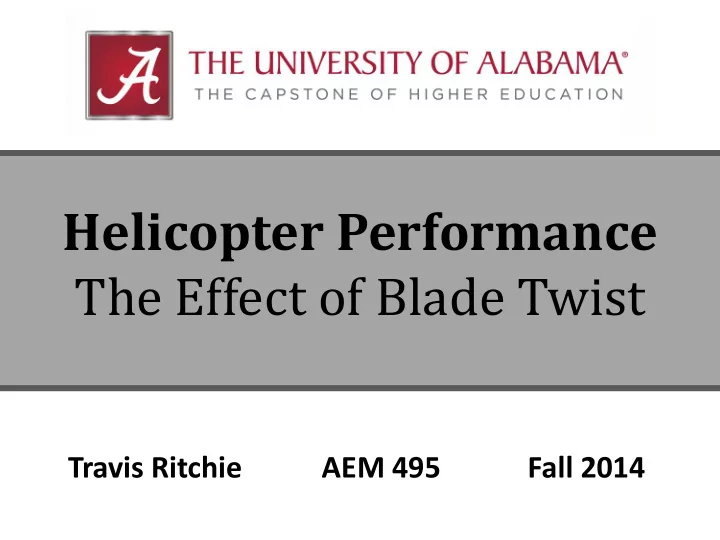

Helicopter Performance The Effect of Blade Twist Travis Ritchie AEM 495 Fall 2014
Introduction Fundamental Helicopter A Design Principle : r B Blade section at Point A travels faster than the Point B section Velocity correlates with lift 0.5 r 𝑀 = 1 2 𝜍𝑤 2 𝑇 𝑠𝑓𝑔 𝐷 𝑚 Circle A Circumference = 2 π r Referred to as asymmetry of lift Circle B Circumference = 2 π (0.5 r )
Blade Twist Concept Manipulate the lift coefficient by varying the pitch angle along the span of the blade z x θ
Blade Twist Visual Pitch angle increases from rotor tip to root 45⁰ 1 5⁰
Lift Distribution Constant Blade Angle Ideal Blade Twist Lift Distribution
Blade Twist Approaches Ideal Blade Twist 𝜄 𝑢𝑗𝑞 𝜄 𝑠 = 𝑠 Linear Blade Twist 𝜄 𝑠 = 𝜄 0 + 𝜄 𝑢𝑥 𝑠
Simulation Parameters Specifications: o Rotor consisting of four rectangular planform blades o Hovering o Neglect tip-loss o Evaluated for: • Ideal Blade Twist • 0⁰ linear blade twist • - 10⁰ linear blade twist • - 20⁰ linear blade twist
Blade Element Momentum Theory Momentum Theory Incremental Thrust Coefficient 𝑒𝐷 𝑈 = 4 𝜇𝜇 𝑗 𝑠𝑒𝑠 = 4 𝜇 𝜇 − 𝜇 𝑑 𝑠𝑒𝑠 Blade Element Incremental Thrust Coefficient 𝑒𝐷 𝑈 = 1 2 𝜏𝐷 𝑚 𝛽 𝜄𝑠 2 − 𝜇𝑠 𝑒𝑠 BEMT equates above equations, solves for the inflow ratio in hover 𝜇 𝑠 = 𝜏𝐷 𝑚 𝛽 16 1 + 32 𝜄𝑠 − 1 𝜏𝐷 𝑚 𝛽
Inflow Ratio
Thrust
Power Incremental Induced Power Coefficient 𝑒𝐷 𝑄 𝑗 𝑒𝑠 = 4 𝜇 3 𝑠 Incremental Profile Power Coefficient 𝑒𝐷 𝑞 𝑒𝑠 = 1 2 𝜏𝐷 𝑒 𝑠 3
Induced Power
Profile Power
Lift Coefficient Incremental Lift Coefficient 𝑒𝐷 𝑚 𝑒𝑠 = 2 𝐷 𝑈 𝜏𝑠 2
Lift Coefficient
Conclusion Blade Twist Improves: • Lift Distribution • Inflow Ratio • Figure of Merit
Recommend
More recommend